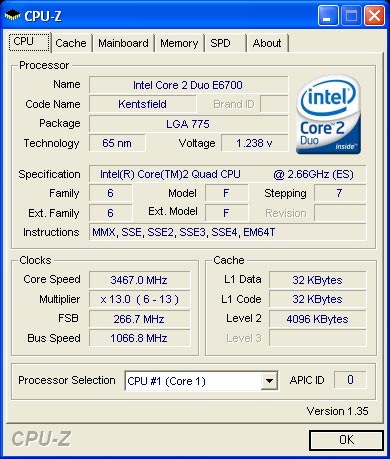Intel's Core 2 Extreme QX6700: The Multi-core Era Begins
by Anand Lal Shimpi on November 2, 2006 2:14 AM EST- Posted in
- CPUs
Overclocking
When Intel's first dual core CPUs hit the market, there was a significant gap in clock speed between them and the fastest single core CPUs. The fastest dual core Pentium Extreme Edition was introduced at 3.2GHz, while you could get a 3.73GHz single core CPU for similar money. The single core Pentium 4 Extreme Edition had a 16.5% clock speed advantage, that you had to give up in order to get a second core at the high end.
Of course back then, clock speed mattered, and it was frequency that got you reasonable performance out of Intel's NetBurst architecture. You gave up much less if you looked at the AMD side of things; their fastest single core CPUs at the time ran at 2.6GHz while the fastest dual core Athlon 64 X2s ran at 2.4GHz.
With Intel's Core microarchitecture, the situation with Kentsfield vs. Conroe is much more like the Athlon 64 vs. Athlon 64 X2. At $999 you've got a dual core 2.93GHz offering or a 2.66GHz quad core offering, and at that price point the decision isn't too hard to make, especially when you take into account that you can overclock Kentsfield pretty well.
Like all other Core 2 Extreme processors, the QX6700 has a mostly unlocked clock multiplier, allowing you to easily overclock to higher frequencies. So while you can't take a Core 2 Extreme X6800 and give it more cores, you can always take a QX6700 and run it at X6800 speeds to have your cake and eat it too.
We managed to get our QX6700 sample up to 3.2GHz (12 x 266MHz) at the CPU's stock voltage of 1.35V, which isn't bad at all considering we didn't employ any exotic cooling. Bumping the core voltage up to 1.3875V we were able to gain an extra 266MHz and run at 3.46GHz.

You lose some overclocking headroom given the added heat output of the extra die on the chip, not to mention that both die have to be capable of running at the overclocked speed, but overall Kentsfield doesn't look too bad as an overclocker's chip. It's not the bang for your buck that the E6300 offers, but at $999 that's not what we're expecting to begin with.










59 Comments
View All Comments
PrinceGaz - Thursday, November 2, 2006 - link
What do you mean it is "a insanely round-about way of measuring power draw"? Can you come up with a better one that doesn't involve cutting tracks on mobos to read the current being passed through them? Or a method which would work equally well with very soon to be released G80 graphics-core which is reputed to dissipate rather a lot of heat (clamp the water-block on that G80 and we'll soon see how much heat it really puts out).If you can come up with a simpler and better method of determining the power usage of CPUs and other devices, feel free to divulge the details here because their current method of measuring at the AC power-outlet is woefully inadequate, and I think a water-block heat-transfer system is not only a simple but quite accurate way of measuring power use, but one that can be applied to both CPUs and GPUs.
autoboy - Thursday, November 2, 2006 - link
Wow, all you guys have really weird methods of measuring power draw. Nearly all the power for modern processors comes through the 12V Aux power connector. You can measure the current and voltage here and you will get the power consumption of the processor. However, the efficiency of the VRM can skew the results slightly.Gigahertz19 - Thursday, November 2, 2006 - link
Ah I like the little hint on the transitor count for Nividia's G80 when they release next week. Can't wait till Nvidia's G80 is released and we get some benchies :)
fikimiki - Thursday, November 2, 2006 - link
Looking at pure encoding performance we can expect only 40-50% increase.It is very,very bad.
Why don't you compare this CPU with Dual-Core Opteron platform?
Without better cache management this CPU is only for benchmarks same as 4x4 it's with crazy pricing.
defter - Thursday, November 2, 2006 - link
Why compare cheaper single-socket platform with more expensive dual-socket platform?
Are you kidding? Kentsfield PC will be cheaper than 4x4 PC, if Kentsfield will achieve same level of performance, then it will have better price/performance ratio.
lopri - Thursday, November 2, 2006 - link
Damn.. I can't get over how gigantic those dice look together.msva124 - Thursday, November 2, 2006 - link
Is the article fully uploaded yet? I got some 404s as I was reading through it.xFlankerx - Thursday, November 2, 2006 - link
Fine for me now. NIce stuff too, as has come to be expected from AT.Chuske - Monday, December 25, 2017 - link
I come from the FUTURE !! In very late 2017, beggining of 2018, quad core CPUs are still very much in use .. even QX6700 and people favourite Q6600 (10$ now) held pretty well, for 11 yo cpus ..